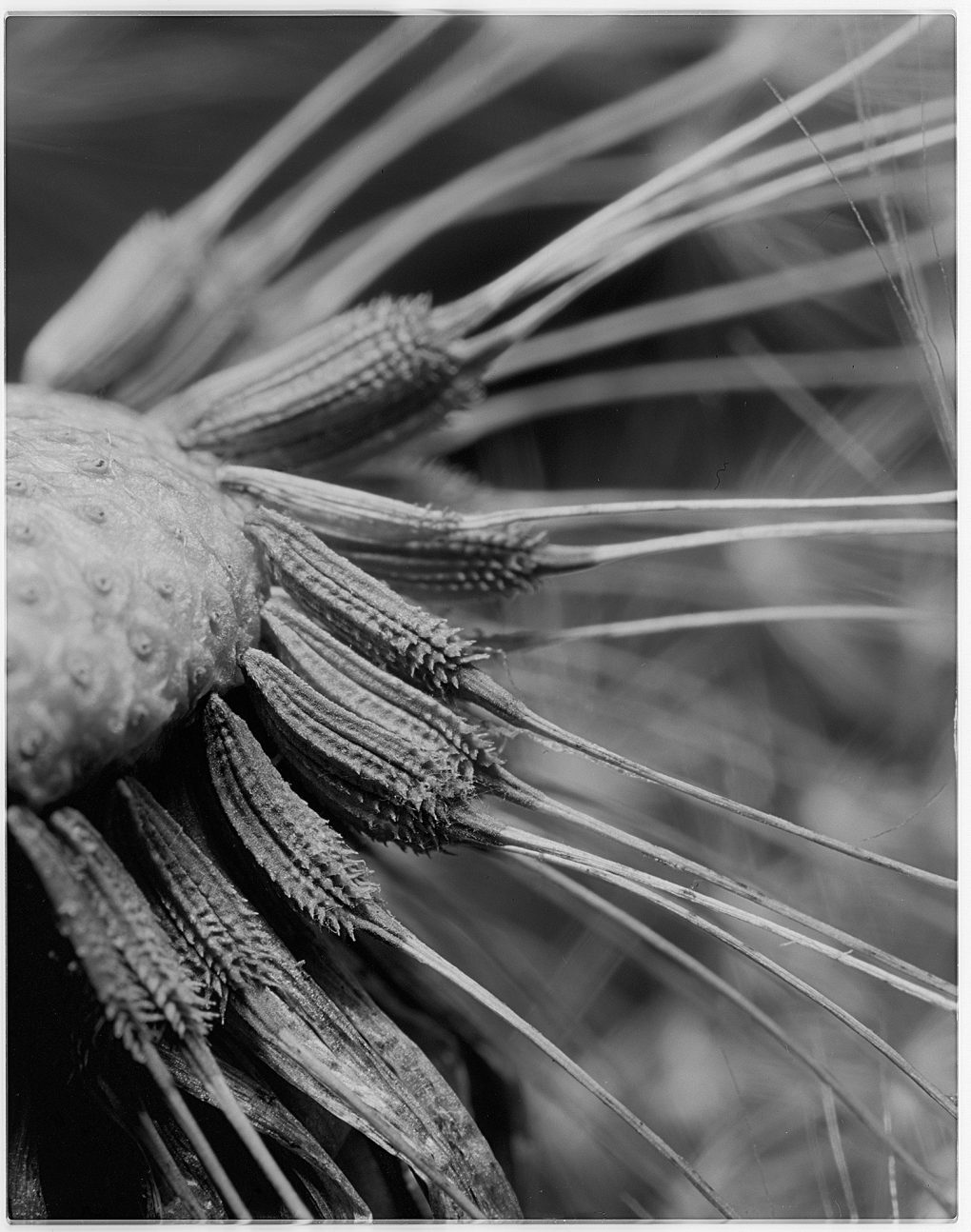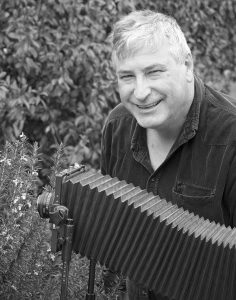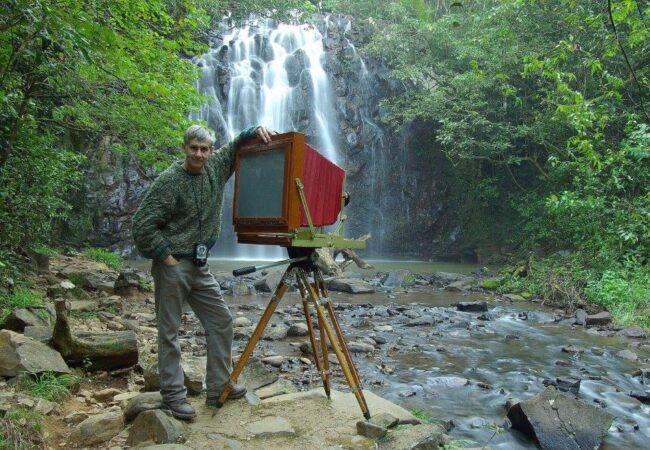Gary Chapman is a photographer who likes to use ultra…

The Photograph Considered number three – Peter Kinchington
Dandelion Seeds
About twenty years ago I had a commission to shoot some 4 x 5 transparencies of Ironbark and Box Woodlands in Central Victoria. I loved the degree of control that a view camera offered as with all its movements it enabled me to capture the image compositions that I had previsualized. I hired the view camera and wide angle lenses for the job and despite being hooked – I could not afford to purchase a large format system for my own indulgence.
Fast forward to March this year and I purchased a 4 x 5 view camera complete with a 90mm f/8 super angulon wide angle lens for a song at a used camera market.
My intention is to primarily use this camera and lens for black and white landscapes and to eventually make carbon prints via digital internegatives. My daughter set me on the carbon print track when she pointed out her favourite print at a History of Australian Photography exhibition at the Brisbane Art Gallery. It was Frank Hurley’s image of men from Shackleton’s Antarctic Expedition battling a blizzard at Cape Denizon. The print had wonderful tonal scale and I assured my daughter that we could also make carbon prints (beware of showing off to your daughter – this will involve me coating and sensitizing rag paper and building a suitable UV exposure system as well as mastering digital internegatives for the required contact printing).
Being somewhat impatient I wanted to try out my new camera immediately – so I chose to do some photomacrography of a suitable subject from my backyard. Some searching and there it was – the classic dandelion seed head.
Ideally for large format photomacrography you would use specialist macro lenses such as zeiss luminars that are optimised for specific magnification ranges or alternatively reversed cine, enlarging or 35mm format macro lenses. I had none of these lenses handy so I reversed my minolta 50mm f/1.4 35mm format lens. This lens is not ideal – but I find careful technique is often more important than lens choice.
Reversing the lens re-establishes the correct optical relationship between the subject and the image at the film plane. We usually use standard lenses to take large subjects and produce a much smaller image at the film plane – in photomacrography we are doing the reverse – we are taking a small subject and making its image larger at the film plane.

I reversed the lens onto the lens board via a step up ring that I attached with black cloth tape. If you have a spare lens board you could use epoxy glue for a more permanent arrangement.

When calculating exposure in photomacrography you need to use the effective aperture.
The effective aperture is determined by using the marked aperture on the lens and multiplying by the magnification plus one.
In my case I closed the marked aperture on the lens to its smallest aperture of f/16. The magnification was 10X lifesize at the film plane or ground glass.
So: effective aperture = 16 x (10+1)
= 176
Small apertures can degrade resolution through a phenomenon known as diffraction – However with nature subjects I trade off resolution for increased depth of field.
I used flash to photograph the Dandelion so I divided the GN of the flash by the effective aperture to arrive at the correct flash to subject distance.
In my case: GN of flash =24m when using 100iso film
=2400cm
The flash to subject distance is: GN of flash/ effective aperture = 2400cm/176
= 14cm
If I had used a constant light source or ambient light the exposure time would have been:
Exposure time calculated for marked aperture x (magnification+1)^2
For instance: I used the marked aperture of f/16 and 100iso film according to the sunny f/16 rule in full sun my exposure time would be 1/100s. The actual exposure time would be: 1/100s x (10+1)^2 = 1/100s x 11^2
= 1.2s
This does not allow for reciprocity failure correction which for my black and white film (fomapan 100) at 1.2s is 3s.
Taking the photograph
- I extended the bellows fully to about 500mm (image 4) with the reversed 50mm lens this gave a magnification of 10X.
- To focus I opened the lens to its widest aperture f/1.4 and moved the tripod until the lens was about 3cm from the dandelion (image 5).
- The front standard was then adjusted to finish focus and camera movements were made to give the required composition.
- The lens was closed down to its marked aperture of f/16
- The film holder was inserted
- Dark slide removed and flash manually fired
- Dark slide replaced. [i]


Negative Development of Fomapan 100
I use stand development in 1+100 dilute rodinal for 1hour at 20 C .
This produces a negative with excellent scanning characteristics to facilitate the production of digital internegatives for making a carbon print.

As a career biologist, my photographs have been utilised for scientific publications and as a way to convey the beauty and diversity of the natural world. I am able to apply my skills in underwater, landscape, nature and photography through the microscope to help others convey their own messages. My images have illustrated publications and exhibitions by many organisations including the Great Barrier Reef Marine Park Authority, Museum of Victoria, Victorian Institute of Marine Sciences, the Commonwealth Scientific Industrial and Research Organisation, Ozbreed Turf and Scienceworks. My photographs have appeared in scientific reports as well as popular technical and photographic magazines and in an online indigenous vegetation guide for the Shire of Yarra Ranges. In the Australian Professional Photography Awards I have received both Gold and Silver Awards for my work. Further recognition includes honourable mentions in specialist world wide photomicrography competitions including the Olympus Bioscape Awards and an image of distinction in the Nikon Small World Awards. I am based in the Shire of Yarra Ranges near Melbourne, Victoria, Australia.
From my childhood days I have been fascinated by the natural world. The first sentence that I wrote in primary school talked about the ants I had observed on our back steps and how they were hurrying back to their nesting holes with food they had collected – even illustrating the sentence with a close-up drawing! Photography enables me to share with others my intrigue with nature – celebrating its infinite diversity and intricate detail. During my photographic pursuit to convey the fascinating natural diversity of the world we live in – I have researched and developed advanced imaging techniques. I am sought after by research institutions and organisations for my ability to utilise these techniques to provide aesthetic images that illustrate important features in organisms both large and small.
[i] The procedure discussed above is my practical approach to photomacrography.
Other factors can effect exposure such as the pupillary ratio of the lens used – for my minolta 50mm f/1.4 this is 1.2 and also the flash to subject angle.




Thanks for a complete explanation. I like studio Macro.
Well done!
Thanks Randy – I think macro is wonderful because it reveals “worlds within worlds”.
Cheers Peter
Excelent work Peter.
I hope you will photograph more of that beautiful unique country you live in?
Hi Paul,
That is fully my intention – not far from my home there are mountain ash forests (Eucalyptus regnans) with an understory of treeferns. Mountain Ash are the tallest flowering plants in the world. Underwater in the ocean we have amazing creatures such as the weedy seadragon and our birdlife is prolific and amazing.
Cheers Peter
Fantastic image – like an SEM but with soul.
Hi Neville,
Thankyou – I think SEM (scanning electron micrographs) are amazing so I really appreciate your comparison.
Cheers Peter